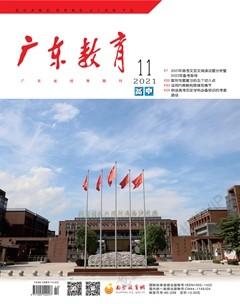巧抓三类词语,提升复述能力
袁兵艳
广东英语听说考试中Retelling 部分主要考查考生的听力理解能力、速记能力和口头表达能力。本文旨在结合考生在训练与考试中反映出的问题探索如何提高基础薄弱考生的故事复述能力。
考生主要存在以下三个问题:
1. 无法协调好听与速记的关系;
2. 无法准确捕捉信息要点;
3. 根据速记要点连句成篇时句子结构不准确。
要解决这些问题,首先得了解故事类文章的主要特点:
1. 动词或动词短语展现故事发展情节;
2. 名词和代词表达故事所讲述的人和事;
3. 形容词体现故事中人物的情感以及人或物的身份、性质或特征。
因此,我们在做故事复述时,要重点听好并记录好动词、名词(或代词)、形容词这三种词。
我们以2021年广东省听说考试A卷为例,具体谈谈如何根据故事类文章的特点来训练,提高故事复述能力。
第一步,在所给故事梗概和关键词中找动词、名词和形容词,为复述作准备。
梗概:Tom儿时扔掉的画被奶奶用心收藏,成名后办画展派上用场。
关键词:drawing(画)throw(扔)grandma(奶奶)exhibition(展览)touched(感动)
动词:throw away(扔掉),collect(收藏),hold(举办)
它们是故事情节发展的关键点,是故事复述过程中要使用到的谓语或非谓语动词,也是复述过程中展现故事情节发展的核心。
名词:Tom,drawing(画),grandma(奶奶),exhibition(展览)
它们是故事中的重要人物、事件和物品,是故事复述时所要用到的主语、宾语或表语,是故事复述的主要对象。
形容词:famous(成名),touched(感动)
它们是故事中人物的特征和感受,是故事复述时的定语或表语,它们使复述的故事变得更加具体和完善。
第二步,记动词或动词短语,抓住故事情節的发展。
听第一遍录音时,争取努力听懂故事情节的发展,同时,在草稿纸上由上而下写出能体现故事情节发展的动词或动词短语,抓住故事发展的起因、过程、高潮和结局。在记笔记的过程中尽量做到一行只写一两个、最多三个动词或动词短语,留出足够宽的空间来添加第二遍听取到的其它信息。如:
... loved ...
wanted to draw ...
... roll up ... throw into ...
... happened ... come ... encourage ... try ...
... went ...
... collected ...
... received ...
... hold ...
... show ... grew ...
... needed ...
... liked ...
... searched ...
... completed ...
... found ...
... ask ... go down ...
... showed ...
... opened ...
... threw away ...
... kept ... marked ... drew ...
... gave ...
第三步,添加重要的名词、形容词,补充时间和地点,完善故事情节发展的过程。
听第二遍录音时,围绕笔记中的动词或动词短语添加体现人物情感变化以及描述人物身份、特征和事物性质特征的形容词、名词,补充故事发生的时间和地点,必要时添加个别重要的副词。故事梗概和给出关键词中已有的名词和形容词无需重复,以免增加速写负担。如:
... little boy ... loved ...
... wanted to draw perfect pictures ...
... bad ... roll up ... throw into ... dustbin ...
... whenever ... happened ... come ... encourage ... try again...
... years went by ...
... now ... famous painter ...
... collected ... art galleries ... country
... one day ... received ... letter
... gallery ... hold ...
... show ... grew ... young learner ... famous painter ...
... needed ... earlier works ...
... liked ... idea
... searched ... house
... completed ... boy
... found ... several ... not enough ...
... ask ... go down ... basement ...
... showed ... huge box
... opened ...
... threw away ... in the past ...
... kept ... marked ... date ... drew ...
... deeply touched ...
... gave ... big hug ...
第四步,用主谓、主谓宾和主系表等基本句型完善复述内容。
1. 主系表常用于复述人物身份、所处状态和人物情感。常用的系动词有be, became和felt等。如:
(1)Tom was a little boy.
(2)He felt bad.
(3)Tom now was a famous painter.
(4)Tom felt upset.
(5)Tom felt deeply touched.
…
2. 主谓、主谓宾常用于描述故事发展过程和结局。如:
(1)Tom loved drawing.
(2)He rolled the drawings up and threw them into the dustbin.
(3)His grandma came and encouraged him to try again.
(4)Tom received a letter from a famous gallery.
(5)His grandma asked him to go down to the basement.
(6)Tom gave her a big hug.
…
我們在复述过程中尽可能使用短句,避免使用长难句。如果遇到长难句,尽可能拆分成短句。如:
The moment he entered the classroom, he saw peter crying to the teacher that someone had stolen his watch.
该句可拆分成三个简单句①He entered the classroom. ②He saw peter crying. ③ Peter told the teacher someone had stolen his watch.
根据以上步骤,我们可以得出以下故事复述参考范文:
When Tom was a little boy, he loved drawing and wanted to draw perfect pictures. If he felt bad about his drawings, he would roll them up and throw them into the dustbin. When this happened, his grandma would come and encourage him to try again. Years went by, Tom was now a famous painter and his works were collected by many art galleries in the country. One day, Tom received a letter from a well known art gallery. The gallery needed his earlier works to hold an exhibition to show how Tom grew from a young learner to a famous painter. Tom liked this idea so he searched the house for his earlier works. But he felt upset because he just found several pieces, not enough for the exhibition. Knowing this, his grandma asked Tom to go down to the basement with her and showed him a huge box. After opening it, he found the drawings he threw away in the past, which were well kept and marked with the date. Tom felt deeply touched and gave his grandma a big hug.
总之,根据上述步骤,我们可以明确在复述的故事中,句子的主语和宾语正是从听力原文中听到并记下的名词或代词,句子的谓语则是从听力原文中听到并记下的动词或动词短语,句子的表语是从听力原文中听到并记下的形容词或名词,而句子的定语是从听力原文中听到并记下的形容词。因此,在备考英语听说Retelling部分时,我们要培养记录动词、名词和形容词,以及用这些词组成结构正确的句子进行故事复述的能力。
责任编辑 蒋小青

